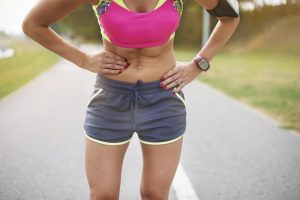

Pickle Me?
Science has not found all the answers to the problems of cramps and stitches, however, well-trained, fuelled and hydrated athletes are at least risk of experiencing muscle cramps.
How to reduce the risk of a cramp:
1. TRAIN
Cramps are less common in athletes who are well trained and conditioned for the event they are training for or competing in
2. FUEL UP
Adequate carbohydrate before and during exercise may prevent premature muscle fatigue increasing the risk of cramping.
3. HYDRATE
Although dehydration alone is not associated with a cramp it can contribute to premature muscle fatigue increasing the risk of cramping.
PICKLE JUICE?

Can a stitch be prevented?
At the moment, the best advice we have to help avoid unwanted stitches during exercise is to limit the risk of friction in the abdomen by:
♦ Allowing two-three hours between eating and exercise to allow time for the stomach contents to empty into the small intestine and avoid food bouncing around.
♦ Be well hydrated and consume small, frequent amounts of fluid during sport to avoid over-stretching the stomach walls.
♦ Avoid highly concentrated drinks, such as soft drinks and fruit juice, immediately before and during exercise, as they empty slowly from the stomach and can leave it expanded for longer.
Thanks to our massage therapist and training dietitian, Coast Sport team member Ali Redman for preparing this blog!
To book in with our sports dietitian Jo Allan, call us on 4356 2588 or book online below!
Acknowelgement: Sports Dietitians Australia and ASD Alan McCubbin.






 Helping the Central Coast Feel Well, Move Well and Perform Well!
Helping the Central Coast Feel Well, Move Well and Perform Well!